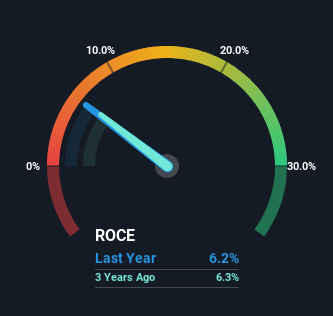Stock Analysis
- United States
- /
- Commercial Services
- /
- NYSE:CXW
Returns On Capital At CoreCivic (NYSE:CXW) Paint A Concerning Picture

To avoid investing in a business that's in decline, there's a few financial metrics that can provide early indications of aging. Businesses in decline often have two underlying trends, firstly, a declining return on capital employed (ROCE) and a declining base of capital employed. This combination can tell you that not only is the company investing less, it's earning less on what it does invest. So after we looked into CoreCivic (NYSE:CXW), the trends above didn't look too great.
Return On Capital Employed (ROCE): What Is It?
For those who don't know, ROCE is a measure of a company's yearly pre-tax profit (its return), relative to the capital employed in the business. The formula for this calculation on CoreCivic is:
Return on Capital Employed = Earnings Before Interest and Tax (EBIT) ÷ (Total Assets - Current Liabilities)
0.062 = US$170m ÷ (US$3.1b - US$304m) (Based on the trailing twelve months to September 2023).
So, CoreCivic has an ROCE of 6.2%. Ultimately, that's a low return and it under-performs the Commercial Services industry average of 9.1%.
View our latest analysis for CoreCivic

Above you can see how the current ROCE for CoreCivic compares to its prior returns on capital, but there's only so much you can tell from the past. If you'd like, you can check out the forecasts from the analysts covering CoreCivic here for free.
What The Trend Of ROCE Can Tell Us
In terms of CoreCivic's historical ROCE movements, the trend doesn't inspire confidence. To be more specific, the ROCE was 7.7% five years ago, but since then it has dropped noticeably. On top of that, it's worth noting that the amount of capital employed within the business has remained relatively steady. Companies that exhibit these attributes tend to not be shrinking, but they can be mature and facing pressure on their margins from competition. If these trends continue, we wouldn't expect CoreCivic to turn into a multi-bagger.
In Conclusion...
In the end, the trend of lower returns on the same amount of capital isn't typically an indication that we're looking at a growth stock. Long term shareholders who've owned the stock over the last five years have experienced a 16% depreciation in their investment, so it appears the market might not like these trends either. That being the case, unless the underlying trends revert to a more positive trajectory, we'd consider looking elsewhere.
CoreCivic does come with some risks though, we found 3 warning signs in our investment analysis, and 1 of those is a bit unpleasant...
If you want to search for solid companies with great earnings, check out this free list of companies with good balance sheets and impressive returns on equity.
Valuation is complex, but we're helping make it simple.
Find out whether CoreCivic is potentially over or undervalued by checking out our comprehensive analysis, which includes fair value estimates, risks and warnings, dividends, insider transactions and financial health.
View the Free AnalysisHave feedback on this article? Concerned about the content? Get in touch with us directly. Alternatively, email editorial-team (at) simplywallst.com.
This article by Simply Wall St is general in nature. We provide commentary based on historical data and analyst forecasts only using an unbiased methodology and our articles are not intended to be financial advice. It does not constitute a recommendation to buy or sell any stock, and does not take account of your objectives, or your financial situation. We aim to bring you long-term focused analysis driven by fundamental data. Note that our analysis may not factor in the latest price-sensitive company announcements or qualitative material. Simply Wall St has no position in any stocks mentioned.

Simply Wall St
About NYSE:CXW
CoreCivic
CoreCivic, Inc. owns and operates partnership correctional, detention, and residential reentry facilities in the United States.
Very undervalued with mediocre balance sheet.
